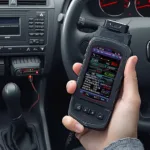OBD2 code 2112, indicating a “Throttle Actuator Control System – Forced Limited RPM,” can be a frustrating issue for any car owner. This code signals a problem within your vehicle’s electronic throttle control system, specifically that the engine control module (ECM) has detected a fault and is limiting the engine’s RPM to prevent further damage. Understanding this code and its potential causes is crucial for effective troubleshooting and repair. Let’s delve into the intricacies of the obd2 2112 code and equip you with the knowledge you need to address this issue head-on.
Decoding the OBD2 2112 Code
The OBD2 2112 code specifically points to a forced limited RPM situation caused by a malfunction within the throttle actuator control system. This system is responsible for regulating the airflow into the engine, directly impacting engine performance and power output. When the ECM detects an anomaly within this system, it activates a failsafe mode, restricting the engine’s RPM to prevent potential damage to the engine or other components. This limitation can manifest as sluggish acceleration, reduced top speed, or even engine stalling. This is often related to issues you might discover when checking obd2 scanner car throttle.
What does a “forced limited RPM” actually mean? It essentially signifies that your car’s computer is intentionally holding back the engine’s rotational speed. Imagine trying to accelerate onto a highway, but your car feels like it’s being held back. This limited RPM can be a safety precaution, but it’s undoubtedly a sign that something needs attention.
Common Causes of OBD2 2112
Several factors can trigger the obd2 2112 code. Pinpointing the exact cause requires a systematic approach to diagnostics. Some common culprits include:
- Faulty Throttle Actuator: The throttle actuator itself can wear out or malfunction due to internal component failure.
- Wiring Issues: Damaged or corroded wiring within the throttle control system can disrupt communication between the ECM and the throttle actuator.
- Throttle Position Sensor (TPS) Problems: A malfunctioning TPS can send inaccurate readings to the ECM, leading to improper throttle control and the activation of the failsafe mode.
- ECM Malfunction: While less common, a faulty ECM can also trigger the 2112 code. This requires specialized diagnostic equipment to confirm.
You might be surprised to learn that sometimes, issues related to fuel flow over obd2 can indirectly contribute to throttle actuator problems and related codes.
What Does OBD2 2112 Mean for Your Car?
Experiencing this code means your car’s performance is compromised. It’s crucial to address this issue promptly to restore proper engine function and prevent further complications. Ignoring the 2112 code could potentially lead to more serious and costly repairs down the line. You might be wondering, “does obd2 tell you about bad fuel pum?” While the 2112 code doesn’t directly relate to the fuel pump, a thorough diagnostic check can rule out any interconnected issues.
Troubleshooting OBD2 2112
Diagnosing the obd2 2112 code requires the use of an OBD2 scanner. This tool allows you to read the specific code stored in your vehicle’s ECM. Once the 2112 code is identified, further diagnostic steps are needed to isolate the root cause. Checking the wiring harness for damage, testing the TPS, and inspecting the throttle actuator are essential steps in this process.
How to Fix OBD2 2112
The specific repair for the obd2 2112 code depends on the underlying cause. It may involve replacing the throttle actuator, repairing damaged wiring, or replacing a faulty TPS. In some cases, a software update to the ECM might be necessary. Consulting a qualified mechanic is recommended for accurate diagnosis and repair, especially if you are unfamiliar with automotive diagnostics and repair procedures.
“Regular maintenance and timely diagnostics are key to preventing many OBD2 codes, including 2112,” advises John Smith, Senior Automotive Technician at Smith Automotive Solutions. “Catching these issues early can save you time and money in the long run.”
Conclusion
The obd2 2112 code signifies a potentially serious issue within your vehicle’s throttle control system. Understanding this code and its implications is crucial for taking appropriate action. By using the information provided in this guide, you can take the first steps toward diagnosing and resolving this issue, ensuring a smooth and safe driving experience. If you’re dealing with throttle-related codes, you might find our resource on etb obd2 codes throttle freestyle helpful as well. Don’t let obd2 2112 slow you down; address it promptly and keep your car running smoothly.
FAQ
- What is the obd2 2112 code? It indicates a fault in the throttle actuator control system, leading to limited RPM.
- What causes obd2 2112? Potential causes include a faulty throttle actuator, wiring issues, or a bad TPS.
- How do I fix obd2 2112? The repair depends on the cause and may involve replacing parts or updating software.
- Is obd2 2112 serious? Yes, it can lead to performance issues and potential damage if left unaddressed.
- Can I drive with obd2 2112? While possible, it’s not recommended, as it can worsen the problem.
- How do I diagnose obd2 2112? Use an OBD2 scanner to read the code and perform further diagnostic tests.
- Where can I find more information about OBD2 codes? You can find more helpful resources on our website, obd2 code 2112.
Need help? Contact us via WhatsApp: +1(641)206-8880, Email: [email protected] or visit us at 789 Elm Street, San Francisco, CA 94102, USA. Our customer service team is available 24/7.


